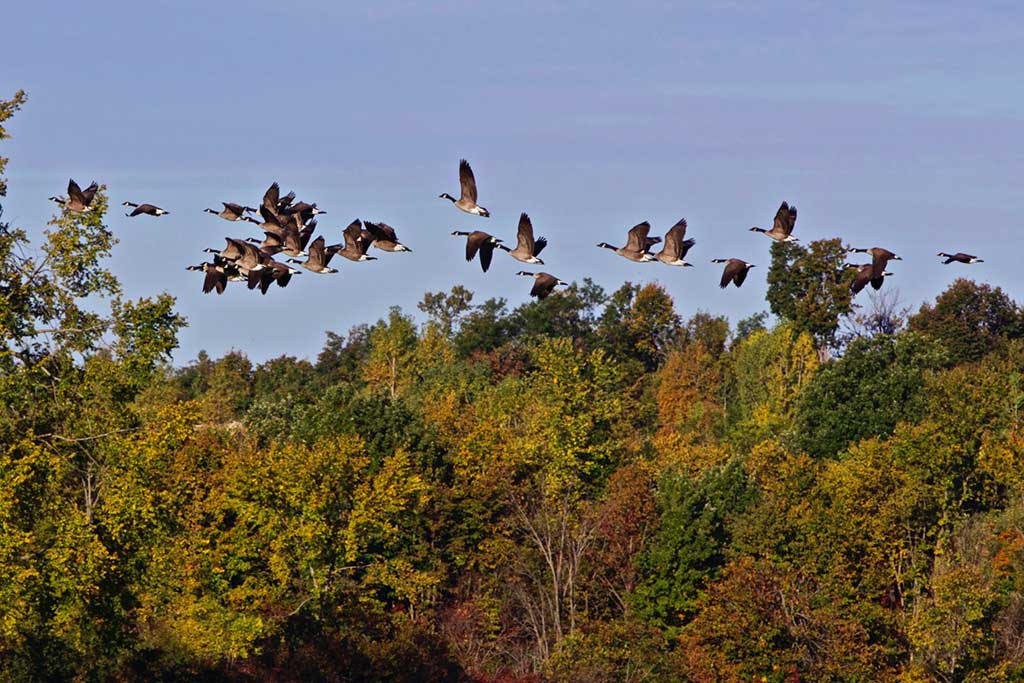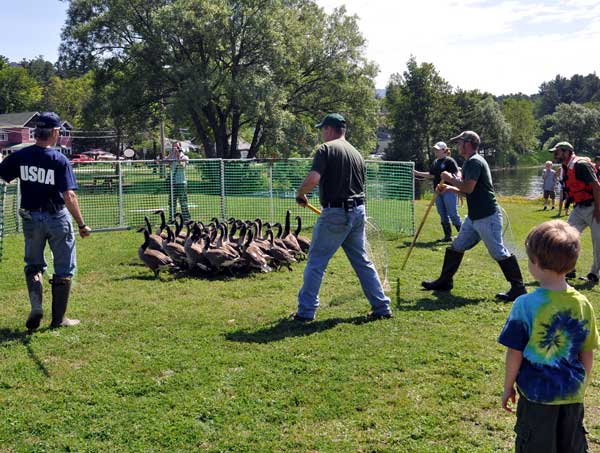The honking harbinger of advancing autumn
What can cruise at an altitude of 29,000 feet, is a beloved icon of the great outdoors, and yet can be the bane of lawn lovers? It’s the honking harbinger of advancing autumn and coming cold (and sometimes, bad alliteration), the Canada goose.
The familiar autumn voices of Canada geese overhead can at once evoke the melancholy of a passing summer and the anticipation of a bracing new season of color and activity. Kids return to school, hunters take to the woods, and farmers work past dusk and into darkness, all to the cacophonous cries and the heartbeat of wings of migrating geese.
Through the end of November and even beyond, waves of airborne athletes—hundreds of thousands in number—will plow their V-shaped squadrons across North Country skies en route from their northern breeding sites to their winter feeding grounds. Canada geese nest in northern Quebec, Ontario, Labrador, and Newfoundland, and winter-over in southern New York State, Pennsylvania, and other regions more hospitable than their arctic nests. Depending on how far north they nest, the migrants may cover nearly 1,000 miles each trip.
When they stop for several days to feed at favorable locations along their migration routes, Canada geese fly low from one feeding ground to the next. They have been documented at nearly 30,000 feet, but during migration they typically fly at about 3,000 feet.
On average, the Canada geese that wing by us in fall measure between 30-40 inches long with a wingspan of 50-70 inches, and weigh 8.5 pounds. The largest wild Canada goose ever measured weighed 24 lbs. and had an 88-inch wingspan, a record among all goose species worldwide. No one claims to fully understand how geese navigate, but the ability to sense the Earth’s magnetic field seems to be critical. Visual cues, star positioning, and even smell may play a role as well.
Among the things that endear Canada geese to us is the fact that they mate for life. From the time they begin breeding at two or three years old until they succumb to old age 20 or 25 years later, these birds remain loyal (for the most part) to their mates. Should one member of the pair die, the other usually selects a new partner.
According to the Cornell Ornithology Lab, there are eleven subspecies of Branta canadensis, the Canada goose, although some authorities only recognize seven. All experts agree, however, that no Canada goose has ever owned a valid Canadian passport even though the species is erroneously called the “Canadian goose” fairly often. The finer points of taxonomic squabbling aside, a more important distinction is the one between migrant and resident geese.
Although there is evidence geese no longer fly as far south as they once did due to a changing climate, the journey is still an impressive one. As far as anyone knows, Canada geese have been migrating between their arctic nurseries and temperate wintering grounds for millennia. In contrast, it appears resident geese are a more recent phenomenon.
A small population of resident Canada geese was documented in New York State in the early 1900s. The New York State Department of Environmental Conservation (NYSDEC) said these were descended from captive birds released downstate by private landowners. As the original population grew and spread, NYSDEC released captive-bred geese in the Albany area in the1950s and 60s, and increased the resident NYS geese population. New York State DEC reports we now have about 200,000 resident Canada geese in the state.
Unfortunately, geese—especially residents—have become pests in parks, on golf courses and home lawns. They are vegetarians and happy to take advantage of grass. Their droppings elicit complaints on aesthetic grounds and because they may be a source of fecal coliform bacteria. When geese pass overhead, it brings a whole new meaning to the phrase “duck, duck, goose.”
Also, male geese can sometimes be aggressive as they seek to protect their young. This is especially true during the 4-6 weeks in June and early July when they are unable to fly well because they have molted and their new feathers are growing in. Balancing the public’s love of wildlife with nuisance complaints and potential health risks is a challenge for public officials.
No matter how much of a problem resident waterfowl may become, I will always thrill to the cries of migrating geese in autumn and spring. The poet Mary Oliver sums it up for me in her poem “Wild Geese.”
“Whoever you are, no matter how lonely, the world offers itself to your imagination, calls to you like the wild geese, harsh and exciting, over and over announcing your place in the family of things.”
Paul Hetzler is a horticulture and natural resources educator with Cornell Cooperative Extension of St. Lawrence County.








.png)

Maybe if people weren’t so in love with grass, they wouldn’t have a problem with geese.
Less grass would be good for all.